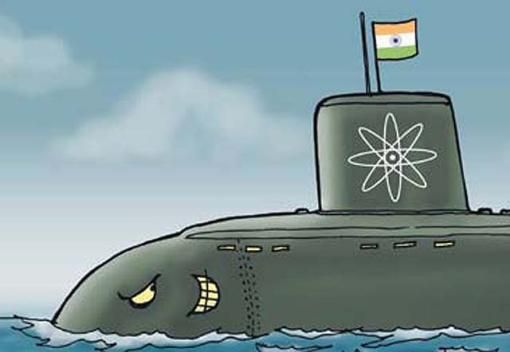The launch of India's first missile-capable nuclear submarine has serious regional implications. It poses response choices for Pakistan to avert strategic imbalance.
India must also reflect on the overarching architecture of relationship it wants to evolve with Pakistan. How far is India's military build up due to its threat perceptions, or motivated by the objective of threat projection and hegemony?
Pakistan, after its breakup in 1971 through Indian military action, continues to perceive that while socio-economic progress and combating extremism constitute core objectives, its main existential threat continues to emanate from India, in which some core policy makers and influential segments may still regard Pakistan's creation as a historical mistake.
Faced with an asymmetrical imbalance in the conventional field from a much larger India, Pakistan's hard-won nuclear capability has kept the peace by providing, through a credible minimum nuclear deterrent, strategic stability in South Asia.
The peace process that began in 2004 between the two countries attempted to manage the different facets of this difficult relationship with the objective of resolving disputes in a peaceful manner.
Talks were initiated on nuclear and Confidence Building Measures (CBMs). Both sides formally declared that the nuclear capabilities of each other, which are based on their national security imperatives, constitute a factor for stability.
Two main agreements on pre-notification of ballistic missile tests and reduction of risks of accidents related to nuclear weapons were signed. Even before India broke off the peace process after the Mumbai incident, the peace process had slowed down.
There was no concrete movement on the core issue of Kashmir, and no promise of movement on Siachin, Sir Creek and the Indus waters which provide Pakistan's life blood.
While the nuclear CBMs agreements continue to hold, there was no forward movement and India wanted to delink itself from Pakistan even in this nuclear field in which New Delhi had reversed the maxim of thinking globally but acting locally.
India was encouraged by a number of developments. The Indo-US nuclear deal, rather than encouraging nuclear restraint in South Asia, enhanced India's strategic capability, freeing its limited uranium reserves for military use, by keeping eight reactors out of safeguards able, to produce fissile material for 280 nuclear weapons annually.
American, Israeli and Russian co-operation in India's Anti Ballistic Missile (ABM) programme further destabilised the strategic balance.
India rejected Pakistan's proposal for a strategic restraint regime with its three interlocking elements of conflict resolution, nuclear and missile restraint and conventional balance, to avoid an unnecessary arms race.
Russia over two decades supported India's nuclear submarine project through technology, technical advice and leasing of nuclear submarines. India's cruise missile Brahmos was jointly developed with Russia.
India will build five nuclear submarines, each carrying 12 nuclear ballistic missiles. The two Akula class submarines to be leased from Russia would carry another 48 missiles.
This submarine leg of India's nuclear triad would deploy some 100 plus nuclear weapons. The other air launched gravity nuclear weapons, land launched ballistic missiles, tactical nuclear weapons and land, air and sea launched cruise missiles would constitute a formidable nuclear delivery capability.
India claims that this build-up is necessary because it faces threats from China and Pakistan. However given the growing relationship between India and China, no objective strategist has been able to postulate any credible conflict scenario between the two countries.
On the other hand, 95 per cent of India's military potential is targeted against much smaller Pakistan. The planned nuclear submarine fleet with its short range ballistic missiles is also Pakistan specific.
Contradicting policy statements of wanting better relations with Pakistan, India's 'cold start' or proactive military doctrine appears to be aimed at rapidly seizing parts of Pakistan while remaining under the nuclear threshold.
The nuclear submarine fleet with its second strike capability is then likely to be used to reinforce pressure on Pakistan not to use nuclear weapons, tactical or strategic, to deter or counter any Indian thrust into Pakistan.
Pakistan has responded that it will take all steps to safeguard its security and to maintain strategic balance in the region. What should Pakistan do? First of all develop its own second strike nuclear submarine based capability.
Secondly, equip its conventional submarines with nuclear tipped cruise missiles.
Thirdly, as Russian assistance has evoked no international objection and is clear that both leasing of nuclear submarines and technology for their production are completely compatible with the global non-proliferation regime, Pakistan should explore such possibilities.
Fourthly, the most important lesson for Pakistan, a latecomer by necessity as a nuclear state, is that while not having to match India, nuclear weapon by weapon, to maintain strategic stability it will need to continue its modest fissile material production in the foreseeable future and cannot brook any developments or negotiations counter to this vital national security requirement.
Faced with these escalating threats, Pakistan must oppose the initiation of negotiations on the Fissile Material Cut-Off Treaty with countries with their own comfortable fissile material stockpiles, who have also helped arm India, want to begin and prioritise in the Conference on Disarmament in Geneva specifically at Pakistan's expense.
And if negotiations begin, not to accept, as India has already declared for itself, any outcome detrimental to Pakistan's security.
Ambassador Tariq Osman Hyder is a retired Pakistani diplomat.
Your comments
Dear Mr. Tariq,
I Dont think that india going to attack your country,Kindly use that money to develop basic infrastructure in your country,the best way is to give job opportunity to the young generation of pakistan,which mean good educations facilities which compete internationally, countrys industralization possible when the country is stable.
Sandeep Desai
Vasco,India
Posted: August 03, 2009, 10:21










